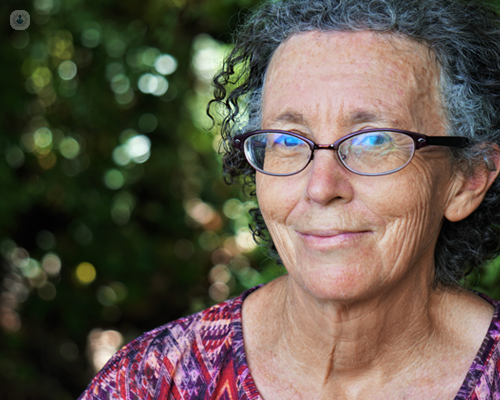Considering HRT… what do I need to know?
Autore:Hormone replacement therapy (HRT) is a safe treatment for women aimed at improving menopausal symptoms. Menopause usually occurs between the ages of 45-55 but symptoms can start before periods stop (perimenopause). If the menopause occurs before the age of 40 years, this is termed premature ovarian insufficiency (POI).
In this article, leading London gynaecologist Mr Michael Magro goes into expert detail about this valuable treatment, considering its benefits, risks and the different types, among other important points.

What are the symptoms of menopause?
- Hot flushes
- Night sweats
- Sleep problems
- Mood swings
- Difficulty concentrating
- Vaginal dryness
- Bladder symptoms
What are the benefits of HRT?
The main benefit of taking HRT is to improve menopause symptoms. It can also reduce muscle loss that commonly occurs after the menopause and improve strength. It also reduces the risk of developing osteoporosis and fractures which is more common after the menopause. In women with POI whose periods stop before 40 years old, then HRT is essential to reduce the risk of fractures, heart disease and stroke.
There are some claims that HRT reduces the risk of getting dementia. HRT is known to improve concentration and a ‘fuzzy head’ that many women with menopause symptoms describe, but there is no good evidence currently that it reduces the chances of developing dementia.
HRT can be taken for as long as it is beneficial. Some risks increase the longer you take it, so it is important that you see your GP or gynaecologist annually for a check-up.
What are the risks of HRT?
For most women with menopause symptoms, the benefits usually outweigh any risks. In some women with liver disease, previous or current breast, ovarian or endometrial cancer and uncontrolled high blood pressure it might not be suitable.
Breast cancer
There can be a small increased risk of developing breast cancer for some women taking combined HRT (4 additional women, per 1000, per year). To put this into context, this is the same risk as women taking the combined contraceptive pill. The older you are and the longer you take HRT, the bigger the risk of developing breast cancer but after stopping HRT the risk falls.
However, newer medications such as micronised progesterone (Uterogestan) are not thought to increase breast cancer risk in the first 5 years, so can be a safer option for many women. In women taking oestrogen only HRT, the risk is actually reduced.
Blood clots
Taking oral HRT (tablets) can increase the risk of developing a serious blood clot in your legs or lungs (Venous thromboembolism). This risk is higher in women taking combined HRT tablets rather than oestrogen-only tablets. The type of tablet is important, as Oestradiol (a synthetic oestrogen) has a lower risk than other forms. What is really good news, is that topical HRT (patches, gels and sprays) don’t increase the risk of blood clots and for many women will be a safer option.
Stroke
If you’re less than 60, the risk of stroke is very small, but HRT tablets can increase the risk of a stroke occurring. Again, the good news is that patches, gels and sprays do not increase this risk.
Most of the serious complications are more common in women who smoke or who are overweight and therefore by cutting down or stopping smoking and by modifying your diet and the amount of exercise you do, the risks can all be reduced for most women.
What are the different types of HRT?
Different women will require different types of HRT so it is important to see your GP or gynaecologist to discuss which is right for you. Women with a womb (uterus) will require combined HRT (contains both oestrogen and progesterone) as the progesterone protects the lining of the womb. In women without a womb or after a hysterectomy, they will only need oestrogen replacement. Some women will also benefit from taking testosterone too.
HRT comes in many forms:
- Tablets
- Patches
- Gels
- Sprays
- Vaginal pessaries/tablets/gels/ring
- Mirena IUS
Some women taking combined HRT will chose to have both hormones taken in the same way (ie- combined tablets/patches), others will choose to take each hormone in a different way. This is dependent on personal preferences and risk factors. This is why choosing the right type of HRT is an important decision and one that your GP or gynaecologist can help by individualising the care to you. Not all women get on well with the first type of HRT they try and it can sometimes take a few months of adjusting the type, route or dose to find something that works well for you.
Cyclical vs continuous
In women with a womb (uterus) it is important that they have both oestrogen and progesterone. In women who have not had a period for over 12 months they take ‘continuous’ HRT which means they do not have any bleeding. In women who are still having periods, they require cyclical HRT, meaning they continue to have a period every month.
Vaginal oestrogen
It’s used to improve symptoms of urogenital atrophy (a lack of oestrogen affecting the vulva, vagina, bladder and urethra) which can cause symptoms such as vaginal dryness and pain, recurrent urinary tract infections, discomfort or pain during sexual intercourse. Because very little gets absorbed it is extremely safe and does not increase the risk of breast cancer, blood clots or strokes. One brand (Gina) can now be purchased over the counter without a prescription.
Testosterone
The menopause also causes the level of testosterone to drop, which can cause a low sex drive (low libido) and can sometimes cause other symptoms such as memory problems, mood changes and muscle weakness. Testosterone isn’t currently licensed to treat the symptoms of menopause, but a gynaecologist can prescribe it to help if you have a low libido. This is usually given as a gel taken daily and in the correct dose does not cause side effects. In excess, it can cause excess hair growth, voice changes and weight gain but these are very unlikely.
Side effects of HRT
Side effects are very uncommon and many women have none but some women will develop some, although most of the time these are mild and resolve within three months. It’s important to remember that there are multiple types of HRT and sometimes the dose, route or type need to be adjusted to suit you as an individual.
Common side effects of both oestrogen and progesterone can be breast tenderness, vaginal bleeding (although this usually resolves in a few months), change in mood, headaches, tummy upset (such as nausea) and for women using topical treatments skin irritation.
Vaginal bleeding for the first three to six months is a relatively common side effect and your gynaecologist will keep this under review. Bleeding after this time may require your HRT to me amended or further investigations such as a hysteroscopy (camera to look inside the womb)
What are the alternatives to HRT?
Not all women will want HRT to treat their menopause symptoms. Losing weight and stopping smoking can both improve symptoms but also reduce long-terms risks, making choosing HRT a safer option for many.
- Exercise can reduce hot flushes, improve muscle strength and aid sleep.
- Reducing caffeine, alcohol and spicy foods can help reduce hot flushes
- Vaginal moisturisers and lubricants can help with vaginal irritation and discomfort during sexual intercourse.
Non-hormonal medications
Some women who can’t take HRT or would prefer to avoid hormones, may benefit from antidepressants (such as Paroxetine) which can help with mood symptoms, anxiety and difficulty sleeping. Clonidine is a non-hormonal alternative that can help relive hot flushes.
Herbal remedies
Many women seek out and use herbal remedies, often bought over the counter to help relieve menopause symptoms. However, there’s limited evidence of any benefit and what the best dose is meant to be. Some will also interact with prescribed medications affecting how they work or causing side effects.
Bio-identical (natural) hormones vs body identical hormones
Bio-identical hormones are made from plants and as such as often referred to as “natural” and often marketed as safe. However, as they aren’t regulated it’s impossible to say what is in them, what the dose is or whether they have any benefit and because of this they are best avoided.
Body identical hormones, however, are regulated and closely testing a nod monitored and therefore are safe.
Oestrogen in the form of 17 Beta-estradiol’ is the most body identical form and taken topically through the skin.
Micronised progesterone (Uterogestan) is a body identical progesterone taken as a tablet in women with a womb (uterus) and has additional benefits in that many women find it helps them sleep and is therefore best taken before bed.
Are there any additional considerations I should make before starting HRT?
Pregnancy
HRT is not suitable if you are pregnant. It is also still possible for women who take HRT to get pregnant, so contraception is required for 2 years after your last period if under 50, or for 1 year if over 50.
Contraception
If you’re taking the combined pill, you cannot take HRT at the same time. You can either continue taking it and then switch to HRT at a later date, usually at the age of 50. It can also be taken for four weeks continuously (without a break) to improve menopause symptoms in women who wish to continue taking it. If you’re using the ‘mini-pill’ (progesterone only pill) or a Mirena coil you can take oestrogen HRT at the same time.
If you need HRT treatment and want advice from one of London’s top gynaecology experts, arrange a consultation with Mr Magro via his Top Doctors profile.


